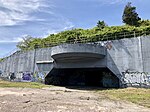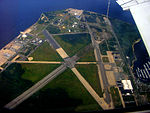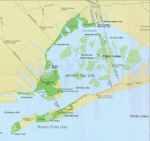Floyd Bennett Field is an airfield in the Marine Park neighborhood of southeast Brooklyn in New York City, along the shore of Jamaica Bay. The airport originally hosted commercial and general aviation traffic before being used as a naval air station. Bennett Field is currently part of the Gateway National Recreation Area's Jamaica Bay Unit, and is managed by the National Park Service (NPS). While no longer used as an operational commercial, military, or general aviation airfield, a section is still used as a helicopter base by the New York City Police Department (NYPD), and one runway is reserved for hobbyists flying radio-controlled aircraft.
Floyd Bennett Field was created by connecting Barren Island and several smaller islands to the rest of Brooklyn by filling the channels between them with sand pumped from the bottom of Jamaica Bay. The airport was named after Floyd Bennett, a noted aviator who piloted the first plane to fly over the North Pole and had visualized an airport at Barren Island before dying in 1928; construction on Bennett Field started the same year. The airport was dedicated on June 26, 1930, and officially opened to commercial flights on May 23, 1931. Despite the exceptional quality of its facilities, Bennett Field never received much commercial traffic, and it was used instead for general aviation. During the interwar period, dozens of aviation records were set by aviators flying to or from Bennett Field.Starting in the 1930s, the United States Coast Guard and United States Navy occupied part of the airport. With the outbreak of World War II, Bennett Field became part of Naval Air Station New York on June 2, 1941. Floyd Bennett Field was a hub for naval activities during World War II. After the war, the airport was used as a Naval Air Reserve station. In 1970, the Navy stopped using Bennett Field, though a reserve center remained until 1983, and the Coast Guard remained through 1998. Several plans for the use of Bennett Field were proposed, and in 1972, it was ultimately decided to integrate the airport into the Gateway National Recreation Area. Floyd Bennett Field reopened as a park in 1974.Many of the earliest surviving original structures are included in a historic district listed on the National Register of Historic Places, being among the largest collections and best representatives of commercial aviation architecture from the period, and due to the significant contributions to general aviation and military aviation made there during the Interwar period. Bennett Field also contains facilities such as a natural area, a campground, and grasslands.









